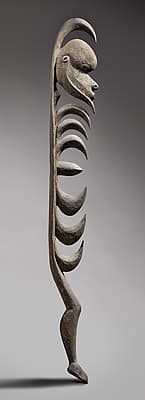
Papua New Guinea, East Sepik Province, Korewori River
Yipwon Early to mid 20th Century , wood, patinas151.0 (h) x 5.0 (w) x 18.0 (d) cm National Gallery of Australia, Canberra NGA 2011.950 Purchased 2011
The Yimam people, who live near the source of the Blackwater River and the nearby Korewori River, are known for their distinctive one-legged sculptures called yipwon. Yipwon display a bold reduction of the human form into an almost two-dimensional plane. Poised on a single leg, they are remarkable for the conception of mass and void formed by the body of opposing curved hooks, which surround a central protrusion. This central element has been interpreted as the heart or soul of the yipwon protected by the hooked ribs, or as a cosmological device of stars around the moon or sun.
These figures, or more specifically, the spirits that inhabited them, assisted in hunting and war. Each figure was carved for a named spirit being and would be kept at the back of the manm ceremonial house. Ritual steps were taken to make the yipwon spirit enter the carved figure, making it ‘alive’ through offerings of magical herbs, lime, the men’s saliva and even their own blood, all of which were applied or smeared onto the figure. It was believed that the spirit of the yipwon went ahead of the hunter or warrior and took their quarry’s spirit, making the pig, cassowary or human easy to be captured and slain. After a successful hunt, blood, meat and liver from the animal were given to the yipwon figure.
The Yimam people, who live near the source of the Blackwater River and the nearby Korewori River, are known for their distinctive one-legged sculptures called yipwon. Yipwon display a bold reduction of the human form into an almost two-dimensional plane. Poised on a single leg, they are remarkable for the conception of mass and void formed by the body of opposing curved hooks, which surround a central protrusion. This central element has been interpreted as the heart or soul of the yipwon protected by the hooked ribs, or as a cosmological device of stars around the moon or sun.
These figures, or more specifically, the spirits that inhabited them, assisted in hunting and war. Each figure was carved for a named spirit being and would be kept at the back of the manm ceremonial house. Ritual steps were taken to make the yipwon spirit enter the carved figure, making it ‘alive’ through offerings of magical herbs, lime, the men’s saliva and even their own blood, all of which were applied or smeared onto the figure. It was believed that the spirit of the yipwon went ahead of the hunter or warrior and took their quarry’s spirit, making the pig, cassowary or human easy to be captured and slain. After a successful hunt, blood, meat and liver from the animal were given to the yipwon figure.
The Yimam people, who live near the source of the Blackwater River and the nearby Korewori River, are known for their distinctive one-legged sculptures called yipwon. Yipwon display a bold reduction of the human form into an almost two-dimensional plane. Poised on a single leg, they are remarkable for the conception of mass and void formed by the body of opposing curved hooks, which surround a central protrusion. This central element has been interpreted as the heart or soul of the yipwon protected by the hooked ribs, or as a cosmological device of stars around the moon or sun.
These figures, or more specifically, the spirits that inhabited them, assisted in hunting and war. Each figure was carved for a named spirit being and would be kept at the back of the manm ceremonial house. Ritual steps were taken to make the yipwon spirit enter the carved figure, making it ‘alive’ through offerings of magical herbs, lime, the men’s saliva and even their own blood, all of which were applied or smeared onto the figure. It was believed that the spirit of the yipwon went ahead of the hunter or warrior and took their quarry’s spirit, making the pig, cassowary or human easy to be captured and slain. After a successful hunt, blood, meat and liver from the animal were given to the yipwon figure.
